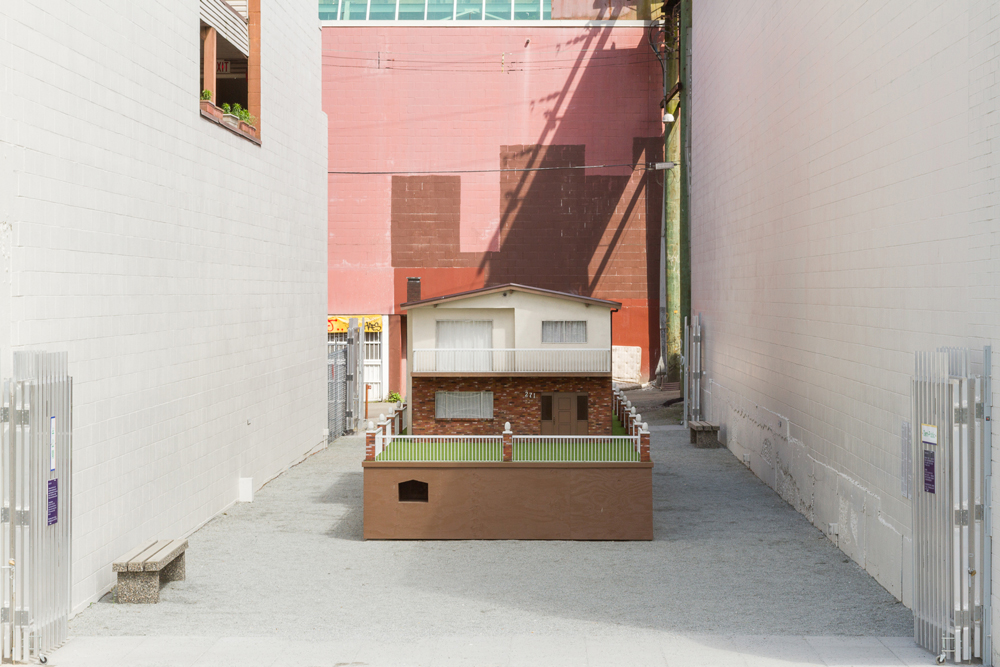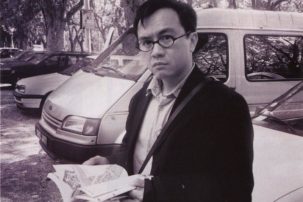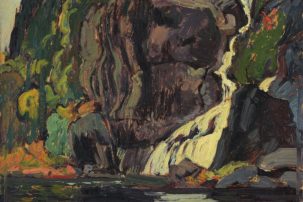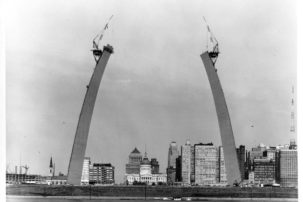Vancouver Especially (A Vancouver Special scaled to its property value in 1973, then increased by 8 fold) (2015) by Ken Lum is the first commissioned work presented by 221A, where I am director, at Semi-Public, a 3,000-square-foot outdoor lot at 271 Union Street, Vancouver. The installation is a 1:3 scale replica of a mass-produced, Vancouver architectural style of home built from 1965 to 1985 and known as the “Vancouver Special.” Most of the estimated 10,000 homes made in this style—a form of accessible home ownership for an ethnically diverse lower-middle class in Vancouver—were at one time perceived as spreading like a virus.
The scale of the artwork is determined by the $45,000 artwork-production budget, comparable to the value of a Vancouver Special in the 1970s. A Vancouver Special bought with that budget today would be tiny (a small notch in the front of the platform shows the actual scale), thus the artwork was expanded eightfold. Therefore, the artwork would be most appropriately considered an “enlargement” of accepted value.
In Vancouver, people watch real estate like sports. Lum’s work was picked up by the real-estate community, making its way into blogs, newspapers and magazines as an artwork that heralds the truth of the market—an obscene marker of success for investors who make money from the struggles of affordability. I want to provide context for this work, beyond the flatness of real estate and into a group of artists working in a neighbourhood undergoing development pressure.
When the editor of Vancouver Magazine called 221A to talk about this work, which appeared on the cover of their September real-estate issue, he started by offering the rhetorical question, “Are you really a citizen if you can’t afford to buy property like your parents or grandparents?” He identified that even the cheapest of the most monotonous condominiums are still $250,000. Yet we are unlikely to live in condominiums, not only because we can’t afford it, but more urgently because they come with a predetermined social morphology—they are designed for someone seeking a solution, not a place to live. Sharing a kitchen between a couple of units is now considered a radical form of “co-location.”
In 2010, prompted by development pressures and a few short months after the Winter Olympics, Centre A organized a symposium that took as its subject “the next 10 years in Vancouver,” from the perspective of various artists and cultural workers. Lum began his allotted speaking time with an anecdote: on his way to the conference he walked through his old neighbourhood of Chinatown, where he noticed one gallery in his former hairdresser’s and another in his former elementary school. He then looked to his peers and remarked, “Stop colonizing my childhood!”
In 2009, only months after 221A opened an exhibition space in Chinatown, a photo of our signage was used in a condominium advertisement nearby. Ginger, the building around the corner, unapologetically featured a marketing campaign with the “cheeky” Orientalist tagline, “Some like it hot. You like it spicy.”
The Canadian Multiculturalism Act, which was only passed in 1988 and lacks critical discussion these days, states that diversity is “an invaluable resource to the shaping of Canada’s future.” It is a resource whereby the dynamism of difference would stoke the fires of the economy—not simply a corrective measure or an issue of barriers to access. Even though the development of condominiums has become the accepted way of funding new third-party civic good, including public art, the sameness of the 200-plus condominium towers in downtown Vancouver is blocking the enhancement of diversity described in the act. These “vertical gated communities” serve to displace more diverse forms of living while de-futuring the land from other potential architectures.
We asked Lum to conduct a walkthrough of Chinatown in late 2010. We learned that the irregular interior of the current dollar store on Pender Street is owed to its first use as a popular Chinese-run bowling alley; Georgia Street was known as the “chicken street”; and Lum’s experience living and growing up in a neighbourhood that was deemed for many years an unhygienic blight in need of redevelopment prefigured that spatial politics today. To our disbelief, we also found that our histories crossed paths, as Lum not only ate the apple tarts at my grandfather Victor Lum’s bakery-restaurant the Hong Kong Café, but that my grandfather was also instrumental in helping Ken’s family adjust to life in Canada.
In 1984, Rosalyn Deutsche and Cara Gendel Ryan wrote a necessary and convincing text chronicling how a number of commercial galleries in New York City took part in the ignorant capitalization of informal neighbourhood relationships. Yet our experience was that the gentrification efforts were long underway in Vancouver’s Chinatown. Various groups had taken part in consistent lobbying for years, leading to the establishment of the Vancouver Chinatown Revitalization Committee in 2000. This certainly does not ameliorate us or other artists of our involvement in urban development, nor of our responsibilities to engage in spatial politics critically, but it does reshape the illusion that is so often naturalized: that artists “bring the horse to the water.”
I remember when, on April 19, 2011, the rezoning of Chinatown’s building heights were relaxed to allow for nine storeys, with some sections up to 15 storeys, by Vancouver City Council. I remember it because the revitalization committee was celebrating at the same time as the arts community. The arts community, who had received reduced funding from the BC Gaming Commission, rallied behind an anti-casino expansion group called Vancouver Not Vegas. City Council unanimously rejected the $500-million casino bid near BC Place stadium, though a smaller casino was eventually built on the site. I have been wondering since about how the casino ruling was politically advantageous. Maybe the rezoning approval in Chinatown may have been more publicly opposed otherwise.
With the changes underway, I began sending images of the various developments in Chinatown to Lum. I was curious to speak about how we might complicate the “preservation of heritage” being used as a counter-solution to the rezoning in Chinatown (the same year the zoning was passed, Chinatown was given National Historic Site designation). I was also interested in what I had heard from my friend Antoni Wojtyra—that Lum had, some years back, been unceremoniously rejected by a developer for a public-art proposal of a replica of the Vancouver Special.
In June 2011, 221A expanded to a second building, across the street at 222 East Georgia Street, where we continue to hold the head-lease, which houses artist-run organization Access Gallery, Publication Studio Vancouver, as well as studios for a number of artists. 221A sublets the spaces at a below-market rate while generating a margin of income on the space. While we receive a significant amount of our resources from our access to government funding, we have yet to overcome the historical bias of pre-existing institutions that hold the majority of the operating funds. And we don’t seek to fight with our colleagues in a cannibalistic funding system. We don’t want to discredit public funds, but we are also not nostalgic for a Eurocentric or anti-American enlightenment project. For now, these rental revenues are the lifeblood of our charitable programming, and have ultimately shaped the ethos of 221A as an institution.
The Yee Fung Toy Society of Canada, a non-profit Chinese benevolent association, owns 222 East Georgia Street. The society is completely volunteer-run, and conducts most of their business in unhurried three-hour meetings in the basement. They now operate unbound by their historic utility as a safe place for the Yee lineage back when cultural minorities were de facto segregated in the area. Until recently, they would post an exact, to the penny, listing of the society’s revenues and expenses on the wall, next to decades of group photos of their five Canadian chapters. One of the lines was the rent we pay them.
When we renovated the Yee building we couldn’t help but think about the rezoning of the neighbourhood, and the impending change. Yet we didn’t realize the extent to which we would find ourselves within the real-estate paradigm. We received capital funding from the city and the federal government at that time, which led to putting up demising walls and upgrading the space for artist studios. For most of its life before that, the space had been a french-cut jean manufacturing and retail business. It was most recently a rice-cooker and small-appliance store.
When we were in the process of completing the renovations I came across an exhibition at the Or Gallery. The exhibition featured work from the architecture faculty at the University of British Columbia and included, to our amazement, a three-dimensional printed tower directly on top of our new premises at 222 East Georgia Street. We witnessed our own “death” just after proudly announcing the security of tenure the arts community would have through the signing of the 10-year lease. This exercise afforded us the levity to speak to the future of spatial politics, and to instill a sense of urgency in our approach.
I became good friends with the rice-cooker owner when they moved out of 222. The fellow suggested that perhaps he could sell rice cookers using the front 10 feet or so of the retail area after we took occupation of the space. We had already promised the space to Access Gallery, but I thought the proposed mix of a Chinese retail business with an exhibition space was a good example of the way businesses and customers in Chinatown weren’t concerned with sharing space.
I would see him on the street in Chinatown from time to time and we maintained a friendly relationship. Then, one day, I noticed that his hair changed significantly. He was sporting a full perm, which seemed out of character. Later, I saw him sitting and laughing loudly while his hair was styled at one of the hair salons around the corner. I found out he was in a relationship with one of the stylists. Rice cookers soon showed up for sale in the hair salon. Our architecture of the future should allow these idiosyncratic configurations.
In 2013, 221A was contacted by a local landowner about using an outdoor vacant lot for the purpose of a community garden. The space is a standard 25-feet-wide by 122-feet-long, with two buildings on either side that create a sense of enclosure or privacy and had made it a habitual place for illegal dumping.
We made an agreement to use the site for the next 10 years at a nominal cost. In exchange, we applied to alter the property-tax classification from commercial-retail to charitable-park, saving the property owner a significant amount on annual taxes. We became interested in how the tax shelter for charitable use postponed the commercialization of space. There was some pressure to take on the trappings of “community” and non-functional leisure. At many points our landlord suggested a few planter boxes, or at least a mural to help the provincial government surveyor identify that we were meeting the precedents of public good. Given the glut of public-art projects in Vancouver required by new developments (which are instantly subordinated to large multi-unit towers), the emptiness was an uneasiness we wanted to maintain and thereby create a relationship to a civic vernacular that is not so quickly disengaged from the daily experience of the city.
At the time that I was speaking with Lum about Vancouver Especially, I was reading “Towards an Architecture of Enjoyment” by Henri Lefebvre. As scholar Lukasz Stanek says in the book’s introduction, Lefebvre critiques spaces of leisure as “sites of the reproduction of labor power and of the bourgeois cultural hegemony over everyday life.” Yet Lefebvre argued that through spaces of leisure “the body regains a certain right to use.” Many of his colleagues then considered any form of pleasure to be indelibly linked to circuits of capital and bourgeois society, maintaining an ascetic condition where the absence of pain was the closest thing to pleasure. Lefebvre looks to ambiguity as the means of social transformation through enjoyment. Yet over-coded sites of leisure become an abstraction of pleasure.
Lum’s Vancouver Especially links public art to the melancholy of the city, marked by anti-Asian sentiment, aesthetic flatness and the logic of the market, yet peculiar and with something of hope. Perhaps Semi-Public will be a space of pleasure, not because of its role as a community amenity, but because of its ambiguity as an empty lot, not exempt from the cruelty of urban processes.
**
This is an article from the Winter 2016 issue of Canadian Art.








